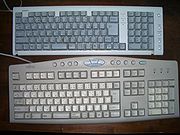
Language input keys
Encyclopedia

Japanese writing system
The modern Japanese writing system uses three main scripts:*Kanji, adopted Chinese characters*Kana, a pair of syllabaries , consisting of:...
and Korean
Korean language
Korean is the official language of the country Korea, in both South and North. It is also one of the two official languages in the Yanbian Korean Autonomous Prefecture in People's Republic of China. There are about 78 million Korean speakers worldwide. In the 15th century, a national writing...
keyboards, for use with an input method editor
Input method editor
An input method is an operating system component or program that allows any data, such as keyboard strokes or mouse movements, to be received as input. In this way users can enter characters and symbols not found on their input devices...
. On non-Japanese or Korean keyboard layouts using an IME, these functions can usually be reproduced via hotkeys, though not always directly corresponding to the behavior of these keys.
Kanji (漢字)

Alt key
The Alt key on a computer keyboard is used to change the function of other pressed keys. Thus, the Alt key is a modifier key, used in a similar fashion to the Shift key. For example, simply pressing "A" will type the letter a, but if you hold down either Alt key while pressing A, the computer...
. Many other 106/109-key keyboards do not label it as the Kanji key. On the Common Building Block
Common Building Block
Common Building Block is a set of technical standards for laptop components introduced by Intel in 2005, and adopted by some manufacturers.-Creation:...
(CBB) Keyboard for Notebooks, the Kanji key is located on the Half-width/Full-width key.
Conversion (変換)
is used to convert kana to kanji. In the Microsoft IME, Conversion selects conversion candidates on highlighted input, and Shift + Conversion is used to display the previous candidate, or zenkōho (前候補). The alt version of this key is also pronounced zenkōho (全候補), which means "all candidates", shows all input candidates.Non-conversion (無変換)
specifies that the kana characters entered are not to be converted into kanji candidates.Half-width/Full-width (半角/全角)
toggles between entering half-width or full-width characters (if 2 versions of same character exists). In Japanese 106/109-key, it is located at the upper-left corner of typing area. It can also be found as shown below.| 半角/ 全角 漢字 |
Hiragana/Katakana (ひらがな/カタカナ)
Used to switch between hiragana or katakana characters. It can also be found for switching between hiragana, katakana and romaji as shown below.| ひらがな カタカナ ローマ字 |
Alphanumeric (英数)
toggles alphanumeric characters. In the Japanese 106/109-key layout, it is located on the Caps Lock key.Han/Yeong (한/영)
Toggles between entering Korean (HangulHangul
Hangul,Pronounced or ; Korean: 한글 Hangeul/Han'gŭl or 조선글 Chosŏn'gŭl/Joseongeul the Korean alphabet, is the native alphabet of the Korean language. It is a separate script from Hanja, the logographic Chinese characters which are also sometimes used to write Korean...
) and English (Yeongja) characters. On the Common Building Block (CBB) Keyboard for Notebooks, this key is located on the right Alt key
Alt key
The Alt key on a computer keyboard is used to change the function of other pressed keys. Thus, the Alt key is a modifier key, used in a similar fashion to the Shift key. For example, simply pressing "A" will type the letter a, but if you hold down either Alt key while pressing A, the computer...
.
Hanja (한자)

Hanja
Hanja is the Korean name for the Chinese characters hanzi. More specifically, it refers to those Chinese characters borrowed from Chinese and incorporated into the Korean language with Korean pronunciation...
) on a Korean keyboard. On the Common Building Block (CBB) Keyboard for Notebooks, this key is located on the right Ctrl key.

